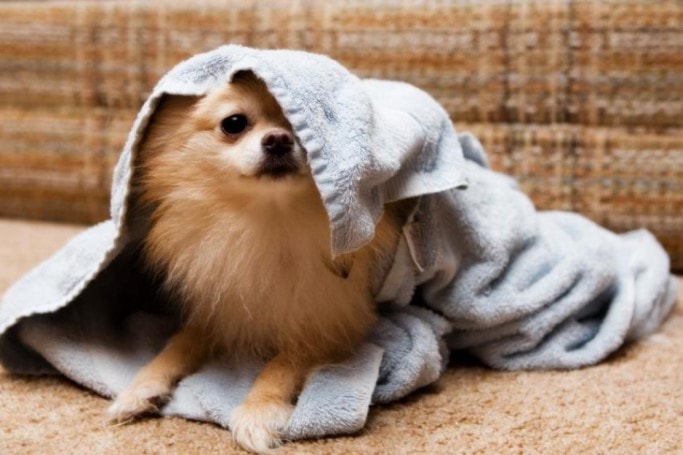Pomeranian Dog Breed Information
| Country of Origin | Germany Poland |
| Nicknames and Other Names | Pom, Spitz Nain, Deutsche Spitze, Pom Pom, Zwergspitz, Spitz Enano |
| Scientific Name | Canis lupus familiaris |
| Breed Type | Purebred |
| Group | Companion Group Toy Group |
| Bred For | Lapdog |
| Size | Small-sized |
| Recognized By | AKC, FCI, CKC, ANKC, NZKC, UKC, KC |
| Life Span | 12-16 years |
| Ideal Weight | 3-7 pounds (male and female) |
| Ideal Height | 6-7 inches (male and female) |
| Fur Type | Dense, medium length, harsh texture |
| Common Colors | Beaver, Blue, Blue Sable, Chocolate Tan, Blue and Tan, Cream, Red, Orange Sable, Orange, Cream Sable, Blue Merle, White |
| Markings | Parti-Color, White markings, Sable, Mask, Tan markings, Irish markings, Brindle |
| Availability | Widely available |
| Achievements | One set the record of the fastest dog |
| Suitable for Apartments | Yes |
| Used in World War | No |
| Most Similar To | German Spitz |
Pomeranian is a cute small dog breed with a colorful history. They are considered to be an ideal companion with a beautiful smile, glorious coat, a face that resembles a fox and a lively personality which make them one of the most popular toy breeds.
The foxy-faced dogs are active and even though they are small they require regular exercise and thrive of training. Pomeranians are small in size but sometimes they forget about their size and will challenge larger dogs.
Origin And History Of Pomeranian
The dog Pomeranian occurs from the region of Pomerania (an area of Poland and Germany). This breed is categorized to be Spitz breed of dogs.
It is quite surprising to know that the original Pomeranian were much larger, weighing approximately about 30 pounds and were bred as sheepherders.
Kennel Club first recognized this breed in 1870. In 1888 Queen Victoria started breeding this dog breed and it was she who made this breed quite popular in England. AKC first recognized this breed in 1888.
Are They Child-Friendly?
These little breeds are very bold and active who loves to play most of their time and are best suited in families with older children. Breeders often refuse to sell Pomeranian puppy to families with small children as they are very tiny in size and too easily get injured if they are accidentally dropped or stepped on by a child.
If you have small children in your family, teach your children how to approach them, and always supervise their interactions to prevent accidents. If these measures are followed then Pomeranian tends to be the best playmate for your children.
Temperament, Personality, And Behavior
The temperaments of Pomeranian is playful, active, sociable, friendly and extroverted. Their activity level makes them
Because they are small in size, they are well suited for apartment living where they can get enough exercise indoors, but they are happiest when they get chance to go for long walks and play with other small dogs.

Image Via Mental Floss
Pomeranians are extremely athletic and can frequently participate in dog sports including agility, obedience, rally, and tracking. They have a very smart and vivacious personality who loves meeting new people and gets well with other animals.
Trainability
Pomeranians are fairly easy to train dogs as they thrive in training. But you should remember that Pomeranians have a short attention span, so keep training sessions short and fun. Reward them with praise and treats whenever they perform correctly, this will help you to motivate them.
When it comes to housetraining, it does not always come
Facts
Interesting facts about Pomeranian are:
Pomeranians were n’t always sotiny before they used to weigh as much as 20 to 30 pounds.- Martin Luther, a leader of the Protestant Reformation has owned a Pomeranian named
Belferlein whom he often mentioned in his writing. - They make wonderful therapy dogs.
- They are also known as Poms or Pom Poms.
Health Issues
| General Health | Healthy |
| Common Health Issues | Patellar Luxation, Cataracts, Epilepsy, Progressive Retinal Atrophy, Dry Eye, Heat Intolerance |
| Hypoallergenic | No |
| Vaccination Required | Rabies, Canine Parvovirus, Canine Distemper, Canine Parainfluenza, Kennel Cough, Leptospirosis, Canine Coronavirus |
| Shedding | Moderate Shedder |
| Drooling | Low Drooler |
| Grooming | Average Grooming Required |
| Weight Gain Potential | Average to High |
| Separation Anxiety | High Chance |
| Allergies | Skin Allergy |
| Diets and Supplements | Protein: 22% for puppy and 18% for adult Fat: 8% for puppy and 5% for adult Antioxidant Digestive Enzymes Glucosamine |
Some health problems your Pomeranina prone to suffer from are:
- Allergies: Some Pomeranians can suffer from a variety of allergies, ranging from contact allergies to food allergies.
- Epilepsy: Some Pomeranians develop epilepsy and have seizures
- Eye Problems: Pomeranians are prone to a variety of eye problems, including cataracts, dry eye and tear duct problems.
Color
Pomeranian are generally found in six color patterns, such as:
- White
- Black
- Tan
- Orange
- Brown
- Grey-sheded
Puppies
The Pomeranians give birth from 1-5 puppies at a time. If you are planning to add a Pomeranian puppy then it can cost you somewhere between $500-$1500 USD.
Which Dogs Are They Similar To?
Dogs similar to Pomeranian are:
- Maltese dog
- Pug
- Poodle
- Shih Tzu
Visit Doglime For More Dog Breed Information.
Tags











One thought on “Pomeranian Dog Breed Information”